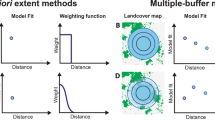Abstract
The effect of plot size was tested on heterogeneous and homogeneous data sets that were obtained by sampling grassland and forest vegetation on plots differing in size. Mean EIV for relevés revealed no differences among data sets from various plot sizes or between homogeneous and heterogeneous data sets. This is probably due to a similar indicator value for species newly occurring in plots with increasing plot size. Using EIV is thus a robust method even for data sets associated with wide range of plot sizes.
Similar content being viewed by others
References
Allen T.F.H., Sadowsky D.A. & Woodhead N. 1984. Data transformation as a scaling operation in ordination of plankton. Vegetatio 56: 147–160.
Bennie J., Hill M.O., Baxter R. & Huntley B. 2006. Influence of slope and aspect on long-term vegetation change in British chalk grasslands. J. Ecol. 94: 355–368.
Chiarucci A., De Dominicis V. & Wilson J.B. 2001. Structure and floristic diversity in permanent monitoring plots in forest ecosystems of Tuscany. For. Ecol. Management 141: 201–210.
Chytrý M. & Rafajová M. 2003. Czech National Phytosociological Database: basic statistics of the available vegetation-plot data. Preslia 75: 1–15.
Chytrý M. Tichý L. & Roleček J. 2003. Local and regional patterns of species richness in central European vegetation types along the pH/calcium gradient. Folia Geobot. 38: 429–442.
Cornwell W.K. & Grubb P.J. 2003. Regional and local patterns in plant species richness with respect to source availability. Oikos 100: 417–428.
Decocq G., Aubert M., Dupont F., Alard D., Saguez R., Wattez-Franger A., de Foucault B., Delelis-Dusollier A. & Bardat J. 2004. Plant diversity in a managed temperate deciduous forests: understorey response to two silvicultural systems. J. Appl. Ecol. 41: 1065–1079.
Diekmann M. 1995. Use and improvement of Ellenberg’s indicator values in deciduous forests of the Boreo-nemoral zone in Sweden. Ecography 18: 178–189.
Diekmann M. 2003. Species indicator values as an important tool in applied plant ecology — a review. Basic Appl. Ecol. 4: 493–506.
Ejrnæs R. Hansen D.N. & Aude E. 2003. Changing course of secondary succession in abandoned sandy fields. Biol. Cons. 109: 343–350.
Ellenberg H. 1979. Zeigerwerte der Gefäßpflanzen Mitteleuropas. Scripta Geobot. 9: 1–97.
Ellenberg H., Weber H.E., Düll R., Wirth W., Werner W. & Paulißen D. 1992. Zeigerwerte von Pflanzen in Mitteleuropa. 2nd ed. Scripta Geobot. 18: 1–258.
Ertsen A.C.D., Alkemade J.R.M. & Wassen M.J. 1998. Calibrating Ellenberg indicator values for moisture, acidity, nutrient availability and salinity in the Netherlands. Plant Ecol. 135: 113–124.
Ewald J. 2003a. The calcareous riddle: Why are there so many calciphilous species in the Central European flora? Fol. Geobot. 38: 357–366.
Ewald J. 2003b. The sensitivity of Ellenberg indicator values to the completeness of vegetation relevés. Basic Appl. Ecol. 4: 507–513.
Hédl R. 2004. Vegetation of beech forests in the Rychlebské Mountains, Czech Republic, re-inspected after 60 years with assessment of environmental changes. Pl. Ecol. 170: 243–265.
Käfer J. & Witte J-P.M. 2004. Cover-weighted averaging of indicator values in vegetation analyses. J. Veget. Sci. 15: 647–652.
Kelly V. & Canham C.D. 1992. Resource heterogeneity in old fields. J. Veg. Sci. 3: 545–552.
Knollová I. 2004. Změny luční a pastvinné vegetace Hostýnských vrchů 1969–2002. Příroda 21: 209–218.
Lennon J.J., Koleff P., Greenwood J.J.D. & Gaston K.J. 2001. The geographical structure of British bird distributions: diversity, spatial turnover and scale. J. Anim. Ecol. 70: 966–979.
Lososová Z., Chytrý M., Cimalová Š., Kropáč Z., Otýpková Z., Pyšek P. & Tichý L. 2004. Weed vegetation of arable land in the Czech Republic and Slovakia: gradients of diversity and species composition. J. Veg. Sci. 15: 415–422.
Moravec J. 1973. The detemination of the minimal area of phytocenoses. Folia Geobot. Phytotax. 8: 23–47.
Øland R.H., Eilertsen O. & Økland T. 1990. On the relationship between sample plot size and beta diversity in boreal coniferous forest. Vegetatio 87: 187–192.
Otýpková Z. & Chytrý M. 2006a. Effect of plot size on the ordination of vegetation samples. J. Veg. Sci. 17: 465–472.
Otýpková Z. & Chytrý M. 2006b. Effects of plot size and heterogeneity of vegetation data sets on assessment of evenness and β-diversity. Ms. (Ph.D. thesis, Depon. in: Dept. Bot. Zool., MU, Brno).
Palmer M.W. & Dixon P.M. 1990. Small-scale environmental heterogeneity and the analysis of species distributions along gradients. J. Veg. Sci. 1: 57–65.
Persson S. 1981. Ecological indicator values as an aid in the interpretation of ordination diagram. J. Ecol. 69: 71–84.
Robertson G.P., Hutson M.A., Evans F.C. & Tiedje J.M. 1988. Spatial variability in a successional plant community: Patterns of nitrogen availability. Ecology 69: 1517–1524.
Rosenzweig M.L. 1995. Species diversity in space and time. Cambridge Univ. Press, Cambridge, 437 pp.
Smart S.M. & Scott W.A. 2004. Bias in Ellenberg indicator values — problems with detection of the effect of vegetation type. J. Veget. Sci. 15: 843–846.
Thompson K., Hodgson J.G., Grime J.P., Rorison I.H., Band S.R. & Spencer R.E. 1993. Ellenberg numbers revisited. Phytocoenologia 23: 277–289.
Tichý L. 2002. JUICE, software for vegetation classification. J. Veg. Sci. 13: 451–453.
van der Maarel 1993. Relations between sociological-ecological species groups and Ellenberg indicator values. Phytocoenologia 23: 343–362.
Wamelink G.W.W., Joosten V., van Dobben H.F. & Berendse F. 2002. Validity of Ellenberg indicator values judged from physico-chemical field measurements. J. Veget. Sci. 13: 269–278.
Wilson S.D. 2000. Heterogeneity, diversity and scale in plant communities, pp. 53–69. In: Hutchings M.J., John E.A. & Stewart A.J.A. (eds), The ecological consequences of environmental heterogeneity, Blackwell Science, London.
Wittig R., Ballach, H.J. & Brandt C.J. 1985. Increase of number of acid indicators in the herb layer of the Miller grass-beech forest of the Westphalian Bight. Angewandte Botanik 59: 219–232.
Wohlgemuth T. & Gigon A. 2003. Calcicole plant diversity in Switzerland may reflect a variety of habitat templets. Folia Geobot. 38: 443–452.
Author information
Authors and Affiliations
Corresponding author
Rights and permissions
About this article
Cite this article
Otýpková, Z. The influence of sample plot size on evaluations with Ellenberg indicator values. Biologia 64, 1123–1128 (2009). https://doi.org/10.2478/s11756-009-0184-6
Received:
Accepted:
Published:
Issue Date:
DOI: https://doi.org/10.2478/s11756-009-0184-6




